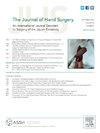A Machine Learning Algorithm to Estimate the Probability of a True Scaphoid Fracture After Wrist Trauma
IF 2.1
2区 医学
Q2 ORTHOPEDICS
引用次数: 0
Abstract
Purpose
To identify predictors of a true scaphoid fracture among patients with radial wrist pain following acute trauma, train 5 machine learning (ML) algorithms in predicting scaphoid fracture probability, and design a decision rule to initiate advanced imaging in high-risk patients.
Methods
Two prospective cohorts including 422 patients with radial wrist pain following wrist trauma were combined. There were 117 scaphoid fractures (28%) confirmed on computed tomography, magnetic resonance imaging, or radiographs. Eighteen fractures (15%) were occult. Predictors of a scaphoid fracture were identified among demographics, mechanism of injury and examination maneuvers. Five ML-algorithms were trained in calculating scaphoid fracture probability. ML-algorithms were assessed on ability to discriminate between patients with and without a fracture (area under the receiver operating characteristic curve), agreement between observed and predicted probabilities (calibration), and overall performance (Brier score). The best performing ML-algorithm was incorporated into a probability calculator. A decision rule was proposed to initiate advanced imaging among patients with negative radiographs.
Results
Pain over the scaphoid on ulnar deviation, sex, age, and mechanism of injury were most strongly associated with a true scaphoid fracture. The best performing ML-algorithm yielded an area under the receiver operating characteristic curve, calibration slope, intercept, and Brier score of 0.77, 0.84, −0.01 and 0.159, respectively. The ML-derived decision rule proposes to initiate advanced imaging in patients with radial-sided wrist pain, negative radiographs, and a fracture probability of ≥10%. When applied to our cohort, this would yield 100% sensitivity, 38% specificity, and would have reduced the number of patients undergoing advanced imaging by 36% without missing a fracture.
Conclusions
The ML-algorithm accurately calculated scaphoid fracture probability based on scaphoid pain on ulnar deviation, sex, age, and mechanism of injury. The ML-decision rule may reduce the number of patients undergoing advanced imaging by a third with a small risk of missing a fracture. External validation is required before implementation.
Type of study/level of evidence
Diagnostic II.
估计腕部外伤后舟状骨骨折概率的机器学习算法
目的探讨急性创伤后桡腕关节疼痛患者发生真正舟状骨骨折的预测因素,训练5种机器学习(ML)算法预测舟状骨骨折概率,设计决策规则,启动高危患者的高级影像学检查。方法将422例腕部外伤后桡性腕关节疼痛患者纳入两组前瞻性研究。117例舟状骨骨折(28%)经计算机断层扫描、磁共振成像或x线片证实。隐匿性骨折18例(15%)。在人口统计学、损伤机制和检查手法中确定舟状骨骨折的预测因素。训练了5种机器学习算法计算舟状骨骨折概率。对ml算法进行了评估,包括区分骨折患者和非骨折患者的能力(受试者工作特征曲线下的面积)、观察概率和预测概率之间的一致性(校准)以及总体性能(Brier评分)。将表现最好的ml算法纳入概率计算器。提出了一个决策规则,以启动先进的影像学检查患者的阴性x线片。结果肩胛骨上的尺偏、性别、年龄和损伤机制与真正的肩胛骨骨折密切相关。表现最好的ml算法在接收器工作特征曲线下的面积、校准斜率、截距和Brier评分分别为0.77、0.84、- 0.01和0.159。ml衍生的决策规则建议对桡骨侧腕关节疼痛、x线片阴性且骨折概率≥10%的患者进行高级影像学检查。当应用于我们的队列时,这将产生100%的灵敏度,38%的特异性,并将接受高级成像的患者数量减少36%,而不会遗漏骨折。结论基于舟状骨疼痛、尺偏、性别、年龄、损伤机制等因素,ml算法准确计算出舟状骨骨折概率。机器学习决策规则可以减少三分之一的患者接受高级影像学检查,并且有很小的骨折缺失风险。在实现之前需要进行外部验证。研究类型/证据水平
本文章由计算机程序翻译,如有差异,请以英文原文为准。
求助全文
约1分钟内获得全文
求助全文
来源期刊
CiteScore
3.20
自引率
10.50%
发文量
402
审稿时长
12 weeks
期刊介绍:
The Journal of Hand Surgery publishes original, peer-reviewed articles related to the pathophysiology, diagnosis, and treatment of diseases and conditions of the upper extremity; these include both clinical and basic science studies, along with case reports. Special features include Review Articles (including Current Concepts and The Hand Surgery Landscape), Reviews of Books and Media, and Letters to the Editor.

 求助内容:
求助内容: 应助结果提醒方式:
应助结果提醒方式:


